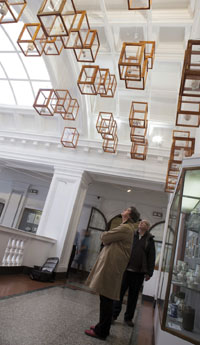Museums are from Mars
Claire Gulliver shares the experiences of a region-wide programme to build collaborations between artists and museums

‘Museums are from Mars, artists are from Venus’, I glibly joked to a colleague on ‘New Expressions’ – a programme to build a culture of collaboration between contemporary artists and museums in South West England. Behind the joke lay a recognition that, in encouraging partnerships between artists and museums, we are dealing in a potentially combustible interplay between parallel worlds: on the one side, historic institutions founded on notions of permanence, materiality and learning; on the other, fiercely autonomous individuals whose concerns are personal, critical, emotional, and whose practice can be as slippery as a bucketful of eels.
It is the belief that this interaction of elements can create powerful cultural experiences that drives New Expressions. And it is the understanding that these collaborations take effort, courage and resilience that leads New Expressions to provide a wider framework for partnership and support among museums embarking on collaborative journeys. Some barriers to teaming up are practical. For example, Cheltenham Art Gallery’s collections team learned that to book artist Neville Gabie, currently in-residence at the Olympic Park, they had to move fast. Plymouth Museum’s project lead, Helen Fothergill, explained: “The pace the museum works at is different to an artist. We’ve learnt to recognise the different timescales.” Different working practices test artists too. The answer is to welcome them: “I enjoy the challenge when a museum says you can’t do something,” says Clare Twomey. “I have to think how to work around it.”
Continuity of the relationship is important. It’s critical that projects are owned by whole organisations and have a dedicated project lead. Effective museums take a whole-team approach to collaboration, setting up working groups and ensuring all staff and volunteers have access to the artist: “It helped to visit Clare’s studio as a team” says Helen Fothergill. “Our marketing and education staff needed to understand the work too.” The project lead at the Royal Albert Memorial Museum, Exeter, moved on midway. “If it had started to go wrong, continuity would have been a problem,” says Blast Theory’s Matt Adams, “but staff have been great, the process went smoothly.”
Local authority museums can confront artists with an unfamiliar public service agenda. Interpretation can be a thorny issue. Museum audiences expect some information about the work. One approach is as simple as a chat about their ideas. A chance for audiences to hear directly from artists contextualises the work, providing ways of looking rather than definitive explanations. But perhaps the most daunting part of working together is the leap into the unknown. Outcomes of creative practice are not defined at the outset and that’s frightening for any organisation under public scrutiny. Successful collaborators are flexible, courageous and prepared to go with the flow. Artist Jeremy Millar, working with North Devon Museum, says: “The museum manager should get credit for being trusting and taking a risk. They could have picked something much easier. In some ways we tore up the brief and that’s challenging to do in an environment that may not always be welcoming.”
Because collaborative working is demanding, New Expressions provides a supportive framework of partnership among museums taking part. Artists are welcome to participate too, though many have no need. Every organisation approaches partnership from a unique position. Funding pressures threaten collaboration: tight resources encourage isolationism or force ineffective marriages of (in)convenience. Some museums are resistant to collaborative working, while others are opportunistic (happily none in this programme). Changing the culture of an organisation, embedding openness and trust is slow work. It’s only by keeping your nerve and building positive, demonstrable successes that mindsets are changed. New Expressions is clear that participants’ relationships with the programme must not be funding driven, but motivated by shared vision. It provides financial support for partners to develop an artist’s commission and deliver public engagement, but it’s not easy money. Collaboration must be in partners’ business plans and they have to work hard, which means committing time. As part of our work to build the heritage sector’s capacity to work with artists, New Expressions organises development activities and field visits to the best examples of collaborative practice. It’s difficult, if you’re a small museum, to take time out for joint activities and visits. “It’s the hardest thing to advocate,” says Cheltenham’s Helen Brown. “You have to argue a lot. But unless you go to see things, your knowledge isn’t good enough, the artists you can think of are too few. The visits were good. It’s made me feel more confident, helped me feel I have my finger on the pulse.”
One reported benefit of being part of a region-wide collaboration is that senior managers feel assured about the strategic picture, and therefore able to allow staff to commit time to partnership activities. It’s also about not feeling alone. Being part of a wider programme makes working together less scary: “Making new things is difficult,” says Clare Twomey. “You feel nervous. The museum feels nervous. But because it’s part of the wider New Expressions partnership, everyone feels more confident. It’s not just sharing the load. It’s participating.”
Join the Discussion
You must be logged in to post a comment.